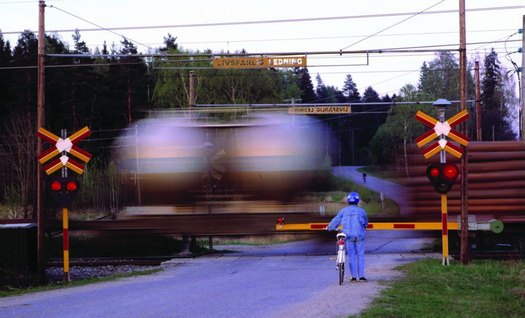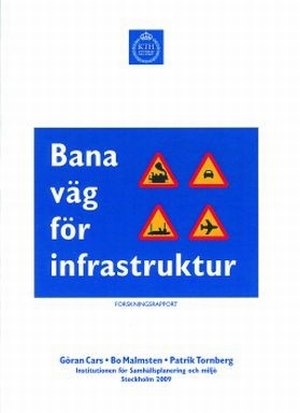
Improving the national or regional transport-infrastructure can easily increase local noise or pollution. Photo: Banverket.
Effectiveness was seen from two dimensions. First, the amount of resources used in terms of time and money. Second, the extent to which implemented projects met the objectives and goals set. In this respect environmental concerns played a key role.
All infrastructure projects per se have environmental impacts. Negative impacts are often direct, e.g. noise and pollution along a new road. Positive impacts are often indirect, e.g. a new commuter train link can increase public transport and reduce road traffic.
Whose perspective?
Perhaps the most important finding however is that environmental concerns have not been handled in an effective way. Vast resources have been allocated to various projects seeking to minimize negative environmental impacts and to promote environmental quality.
Despite both the stated level of ambition and of investment undertaken the results thus far can only be characterized as sub-optimal. The resources available could undoubtedly have been used more effectively it they had been allocated differently. The core of the problem is the inherent tension between local and regional/global perspectives. One conclusion from our research is that local environmental impacts are given substantial attention while regional/global effects are often neglected.
A number of case studies dealing with infrastructure projects were carried out. The findings from the case studies amply illustrate this problem. Following the construction of the bridge between Malmö and Copenhagen Malmö Region is now growing fast. In the region itself sustainable urban growth has been afforded top priority on the political agenda.
The railroad system is being developed and extensive investment has been made in expanding commuter train services. The rail link between Malmö and Lund is however characterized by congestion and a substantial future increase in demand is forecast. In consequence, plans have been laid to double the number of tracks from two to four. This project is logical given the objectives of sustainable urban development.
Burlöv acts local
Along the line between Malmö and Lund lies the municipality if Burlöv. The local environment of Burlöv will be negatively impacted by the new tracks and additional train traffic. The frequency and level of noise will increase. In parallel it should be noted that the municipality of Burlöv will not itself see any direct gains from the new tracks, as to a large extent they will only be used for long distance services which will pass through Burlöv without stopping.
The plan to expand the number of tracks in Burlöv has met with fierce local resistance. Local interest groups and local politicians point out that the new tracks will severely damage the local environment. The level of protest encountered, moreover, ensured that the project came to a standstill for some time with implementation being substantially delayed.
From an academic perspective the core of the problem lies in the tension between the local and the regional and global environmental impacts of such a planning decision. Primarily the issue highlights the paucity of methods and the absence of mechanisms available to adequately compare the impacts of such a decision at the various levels of geographical impact.
Värmdö is revolting!
Experiences parallel to the case described above are frequent in our research project. One case dealt with a proposed new navigable route from the Baltic Sea to Stockholm. The current route has obvious disadvantages. It is long and winding, and some parts are narrow increasing the risk of accidents.
The new route proposed by the Swedish Maritime Administration has obvious advantages. It is shorter and thus it will lead to lower levels of CO2 emissions, it is safer and it is located in such a way that it will have less negative impacts on water and marine life.
Despite these substantial advantages the proposed new route has met with strong resistance in the municipality affected, Värmdö. In spite of the obvious benefits seen from a regional economic and environmental perspective local Värmdö interests oppose it. The new route creates no value for the municipality of Värmdö. No ships on their way to Stockholm will make intermediate stops in Värmdö, and the new route will cause negative impacts in terms of waves from the ships and other disturbances in the calmness of the archipelago's landscape.
Even though these negatives might seem to be marginal when compared to the regional and global environmental advantages they nevertheless formed the basis for Värmdö's resistance to the project. Värmdö's behaviour is not based on ignorance or on a lack of information. Rather the municipality's resistance can be explained by the lack of incentives offered to support the project. Negative municipal impacts, even if they are only marginal, are more important than substantial positive regional and global impacts.
Birdlife is important
In the case of the new railroad between Umeå and Örnsköldsvik (Botniabanan) the project was delayed more than a year and implementation was conditioned on the basis of the promise of numerous environmental investments. All in all, additional costs due to such environmental demands exceeded 1 billion SEK.
The delays were due, in the main, to protests and legal processes based on environmental concerns. Much of the environmental focus was directed at the point where the railway crossed the Umeå River (Umeälven) and on the assumed negative impacts on the birdlife in the delta area.
The arguments raised by those opposing the project have however been questioned by environmental experts. At the same time our research has shown that the project, in addition to these local impacts, also has significant positive global environmental impacts. The new railroad will lead to a substantial decrease in road traffic as it provides a timely and cost effective alternative for goods as well as passenger traffic.
Summing up the findings of our project case studies we conclude that current planning and decision-making procedures are ineffective. These arrangements for planning and for the implementation of infrastructure investments have been set up with the best of intentions, not least to safeguard environmental qualities. In reality however these ambitions are simply not being met.
"The road to hell is paved with good intentions" but it is undoubtedly the case that current procedures often lead to sub-optimal results in respect of environmental quality. Our research clearly shows that local environmental impacts play a vital role in the planning process for infrastructure (even though they are often relatively less important) while regional and global impacts (even though often significant) are forgotten or afforded only a subordinate role.
A holistic approach
Current arrangements for assessing and handling environmental impacts in infrastructure projects are thus ineffective. They are time consuming, costly and do not safeguard environmental interests in an effective manner.
The way ahead to more effective practices lies in holistic assessments of the impact of a project. These assessments must include an analysis of, and the giving of weight to, local as well as regional and global environmental impacts.
By Göran Cars, Professor, KTH - Royal Institute of Technology

The project is presented in the book Bana väg för infrastruktur (Cars, Göran, Malmsten, Bo and Tornberg, Patrik). Royal Institute of Technology (KTH) Department of Urban Planning and Environment, Scientific report 2009.